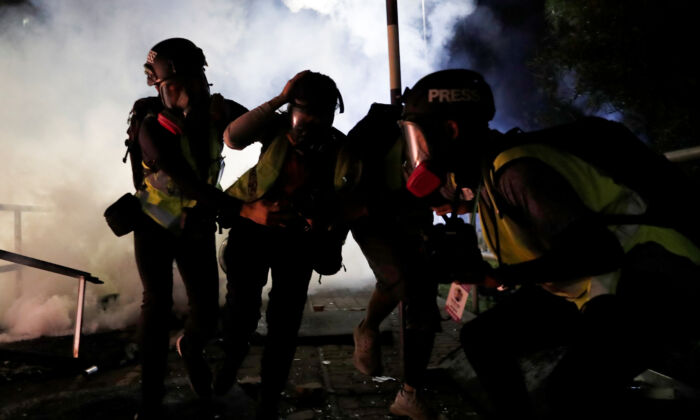A Hong Kong university turned into a battleground on the evening of Nov. 12 as riot police fired water cannon, tear gas, and rubber bullets amid intense standoffs with protesters.
At nightfall, police approached the Chinese University of Hong Kong (CUHK) in the New Territories area, firing volleys of tear gas at students who built makeshift barricades to prevent officers from entering. Students threw bricks and petrol bombs at the police in response.
CUHK Vice Chancellor Rocky Tuan was among those affected by tear gas after he failed to negotiate an agreement for the police’s withdrawal.
Police also fired projectiles, hitting at least one student in the eye and another in the face. A few reporters covering the scene were also injured in the head, according to local media.
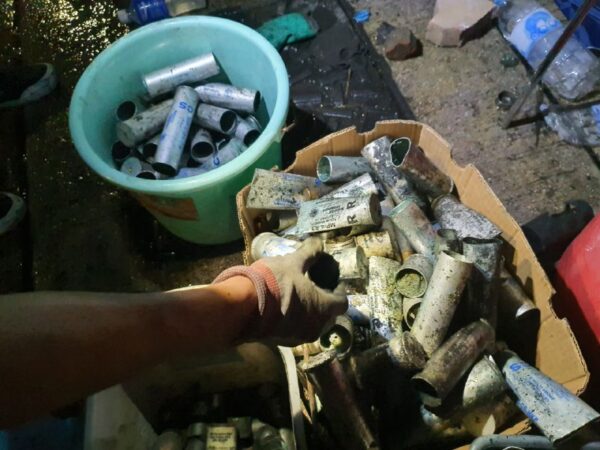 Used tear gas shells are collected into buckets and boxes at Chinese University of Hong Kong in Hong Kong on Nov. 12, 2019. (Sung Mingguo/The Epoch Times)
Used tear gas shells are collected into buckets and boxes at Chinese University of Hong Kong in Hong Kong on Nov. 12, 2019. (Sung Mingguo/The Epoch Times)Violent Clashes
Earlier in the day, riot police charged into the Sha Tin campus of CUHK and made multiple arrests. Tear gas billowed across the university’s sports ground as protesters fled advancing police. Police also fired tear gas inside City University in the Kowloon Tong area.
Protesters had blocked roads near the two schools on the morning of Nov. 12 amid calls for a citywide strike, in widespread anger over the death of a 22-year-old protester, Alex Chow Tsz-lok.
Chow, a computer engineering student, died on Nov. 8 after falling from a parking garage following clashes with police in the neighborhood of Tseung Kwan O.
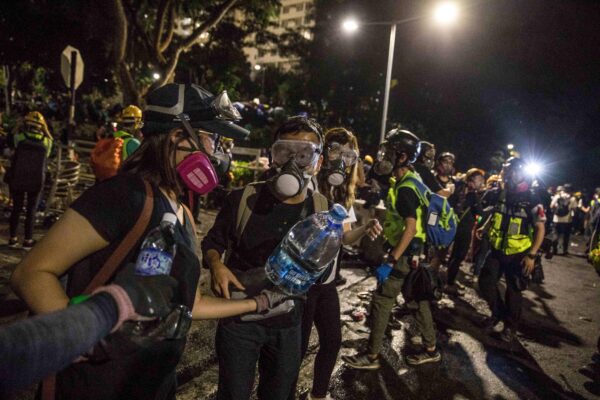 Protesters form a line to pass water to frontline protesters during clashes with police at the Chinese University of Hong Kong (CUHK) in Hong Kong on Nov. 12, 2019. (Dale de la Rey/AFP via Getty Images)
Protesters form a line to pass water to frontline protesters during clashes with police at the Chinese University of Hong Kong (CUHK) in Hong Kong on Nov. 12, 2019. (Dale de la Rey/AFP via Getty Images)A footbridge at the outskirts of the campus became the site of an hours-long standoff at nightfall, with police firing tear gas shortly before 7.30 p.m., according to Hong Kong Free Press.
Earlier in the evening, Tuan had attempted to talk with the police. The police refused, saying it was not time to talk and asked him to leave, according to local broadcaster RTHK. The police then fired tear gas at close range. The school’s vice president, Dennis Ng, said that he also sought a truce with the police, but was told that negotiation was useless, according to Stand News.
At around 10 p.m., the police water cannon truck arrived at the bridge, firing blue-dyed water to disperse the protesters. Shortly after, police announced in a statement that they would retreat from CUHK in “pursuit of a peaceful solution.” But journalists at the scene witnessed tear gas still being fired.
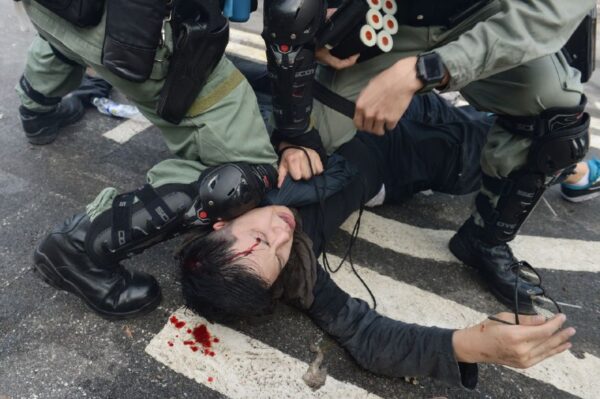 Police arrest a protester at Chinese University of Hong Kong on Nov. 12, 2019. (Sung Pi Lung/The Epoch Times)
Police arrest a protester at Chinese University of Hong Kong on Nov. 12, 2019. (Sung Pi Lung/The Epoch Times)At 11:30 p.m., police released another statement, saying they had “reached a consensus” with the university “in search of a peaceful solution.” They also accused protesters of intensifying the situation to “a deadly level,” saying that they had “no choice but to deploy the minimum necessary force.”
Clashes continued until almost midnight in multiple districts after police withdrew from the campus, including Tuen Mun, Tin Shui Wai, Yuen Long, and Sham Shui Po.
Shortly after midnight, a tear gas canister hit the gas station near the CUHK campus, causing a large fire.
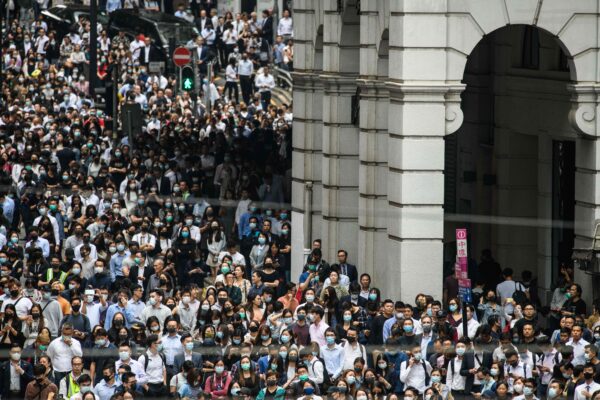 Office workers and pro-democracy protesters gather during a demonstration in Central in Hong Kong on Nov. 12, 2019. (Anthony Wallace/AFP via Getty Images)
Office workers and pro-democracy protesters gather during a demonstration in Central in Hong Kong on Nov. 12, 2019. (Anthony Wallace/AFP via Getty Images)Earlier, several thousand protesters also staged demonstrations in the central business district at lunchtime, chanting “five demands, not one less,” while holding up one hand. Since June, protesters have called for universal suffrage and an investigation into alleged police brutality in demonstrations sparked by a now-withdrawn extradition bill.
On Nov. 11, a police officer shot an unarmed 21-year-old in the abdomen, marking the third protester injured by live rounds fired during the unrest.
The police shooting had prompted international criticism, including from U.S. lawmakers, including Sen. Marsha Blackburn (R-Tenn.), who dubbed the incident “Tiananmen Square 2.0.”
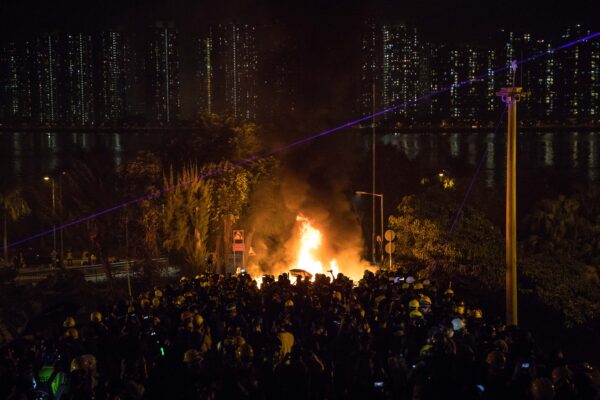 Protesters gather on a bridge as a barricade burns after clashes with police at the Chinese University of Hong Kong (CUHK) in Hong Kong on Nov. 12, 2019. (Dale de la Rey/AFP via Getty Images)
Protesters gather on a bridge as a barricade burns after clashes with police at the Chinese University of Hong Kong (CUHK) in Hong Kong on Nov. 12, 2019. (Dale de la Rey/AFP via Getty Images)Reactions
In an early morning press conference on Nov. 13, police said they had retreated from the CUHK campus by 10:15 after deploying a “crowd control vehicle.” The spokesperson, Yolanda Yu, said that they deployed officers to a footbridge in response to protesters throwing objects onto the highway underneath in the afternoon.
A day prior, Hong Kong leader Carrie Lam said the protesters were planning to “paralyze Hong Kong” and accused them of being “extremely selfish.” She stressed that she would not give in to the demands of the “rioters.”
“I do not want to go into details, but I just want to make it very clear that we will spare no effort in finding ways and means that could end the violence in Hong Kong as soon as possible,” she said during a weekly press conference on Nov. 11.
In an earlier press conference, China’s foreign ministry said the “central government firmly supports” the Hong Kong government and the police force.
The Hospital Authority said it treated 51 people who had been injured, aged between 10 months and 81 years old, during the clashes on Nov. 12, with one in serious condition.
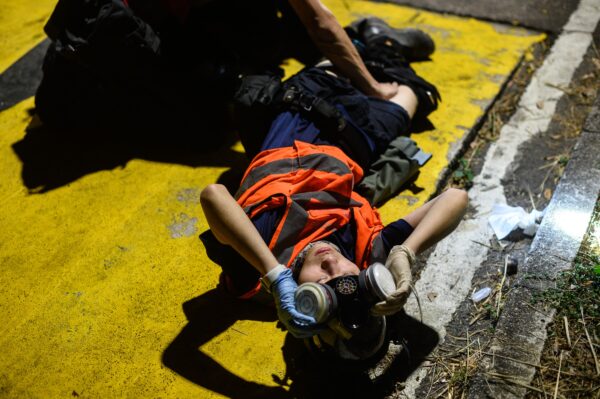 A medic is injured during clashes with police at the Chinese University of Hong Kong (CUHK) in Hong Kong on Nov. 12, 2019. (Philip Fonga/AFP via Getty Images)
A medic is injured during clashes with police at the Chinese University of Hong Kong (CUHK) in Hong Kong on Nov. 12, 2019. (Philip Fonga/AFP via Getty Images)Student unions from at least 14 schools issued a statement on Nov. 12 condemning the police and vowing to “live and die with CUHK” following the clashes.
Meanwhile, 24 pro-democracy legislators made an urgent appeal for international aid, saying that the nonstop firing of tear gas had turned the university into a battlefield.
They added that the police firing on campuses—marking the first such move since the pro-democracy protests broke out in June—was alarming and indicated harsher measures from the government. They also noted an escalation of violence since Lam returned from a trip to Beijing last week, when she received backing from Chinese leader Xi Jinping and the regime’s top official overseeing the city’s affairs.
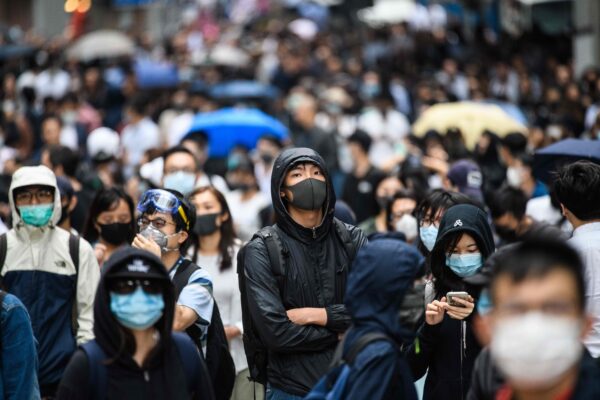 Office workers and pro-democracy protesters gather during a demonstration in Central in Hong Kong on Nov. 12, 2019. (Anthony Wallace/AFP via Getty Images)
Office workers and pro-democracy protesters gather during a demonstration in Central in Hong Kong on Nov. 12, 2019. (Anthony Wallace/AFP via Getty Images)“As an elite raised in Hong Kong, Carrie Lam has now turned into a monster as she carries out the orders to suppress the students who are trying to defend their schools and city,” the lawmakers said.
Around 660 academics and university administrators in Hong Kong and from around the world have also signed a joint statement condemning the “police attacks” on campuses, and raising concerns that the police were entering the grounds “without clear targets of arrest nor search warrants.”
They also urged the Hong Kong government to resolve the crisis with restraint, and warned that they would “reconsider … partnerships with Hong Kong universities in the future if student’s safety is at risk and such blatant violation of academic and intellectual freedom continues.”
This article is from the Internet:Police Besiege Hong Kong Campus in Nighttime Clashes With Student Protesters
Supreme Court Justices Appear Inclined to Allow Trump to Terminate DACA
